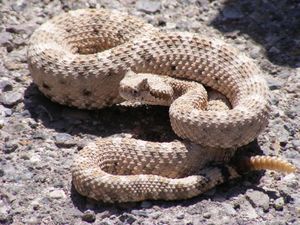We need you! Join our contributor community and become a WikEM editor through our open and transparent promotion process.
Crotaline (Pit Vipers)
From WikEM
Contents
Background
- The Crotalinae subfamily of Viperidae classifies the, new world vipers, or pit vipers. The snakes have a pitlike depression behind the nostril that contains a heat-sensing organ used to find prey.
- Includes rattlesnakes and copperheads
- Venom causes local tissue injury, coagulopathy,and thrombocytopenia
- Up to 25% of bites are dry bites
Common Crotaline snake names
- Rattlesnake
- Cottonmouth
- Copperhead
- Sidewinder
- Water moccasin
- Massasauga
Venom
- Venom form a Crotaline mainly damages local tissue via metalloproteinases and hyaluronidase which cause swelling edema and damage to capillaries.
- Clinical effects consist of:
- local tissue damage
- Coagulapathies (pro and anti effects)
- Platelet dysfunction
- Neurotoxic effects
Clinical Features
- Fang marks, localized pain, progressive edema extending from bite site
- Nausea/vomiting, oral numbness/tingling, dizziness, muscle fasciculations
- Ecchymoses may appear within minutes to hours
Differential Diagnosis
Evaluation
Work-Up
- CBC
- Coags
- Fibrinogen
- Chemistry
Evaluation
- Local injury (Pain, Progressive Swelling, Lymphangitic spread with pain in the axillae for upper extremity bites or pain in the inguinal region for lower extremity)
- Hematologic abnormality (thrombocytopenia, prolonged PT, hypofibrinogenemia)
- Systemic effects (hypotension resulting from third spacing)
Management
Local Care
- Do:
- Immobilize limb in a neutral position
- Remove all jewelry
- Do not:
- Attempt to suck out the venom
- Place the affected part in cold water
- Use a tourniquet or wrap
Crofab administration
- See below
Supportive care
- IVF and pressors if needed for hypotension
- Blood components rarely needed
Crotalidae Polyvalent Immune Fab (FabAV) Antivenin (Crofab)
Indications
The following are criteria for administration after Crotalidae bite [3]
- Progression of swelling
- Abnormal results on lab tests (platelet < 100,000 or fibrinogen < 100)
- Systemic manifestations (unstable vitals or altered mental status)
Dosing and Administration
- Administer antivenom as soon as possible if the indications are met and antivenom is available.[1]
- Administration should slow swelling and decrease pain
Initial Administration
CroFab is reconstituted in normal saline and typically diluted into 250 cc or 1 L of normal saline and infused over an hour.
- The dosing of CroFab is the same for adults and children (may have to adjust the dilution of CroFab for small children so that they are not volume overloaded)
- Establish initial control of envenomation by giving 4-6 vials
- Control achieved? (Cessation of progression of all components of envenomation, including labs checked 2 hours after infusion started)
- If yes: then perform serial exams and consider maintenance therapy
- If no: repeat infusion of 4-6 vials and then re-evaluate for control
Maintenance therapy
- Maintance therapy may be indicated after initial dosing based on local protocols even if control is achieved.[2]
- Infuse 2-vial doses at 6, 12, and 18hr after initial control achieved
Envenomation control measurement
- Must observe for progression of envenomation during and after antivenom infusion
- Measure limb circumference at several site above and below bite
- Mark advancing border of edema q30min
- Repeat labs q4hr or after each course of antivenom (whichever is more frequent)
Antivenom Side Effects
- Acute allergic reactions occur in <10% pts
- If occurs stop infusion and give epinephrine/antihistamines if needed
- Recurrent thrombocytopenia has been described up to 2 weeks after transfusion with FabAV and is likely a result of isolated renal clearance of FabAV and persistent presence of actual venom in serum.[3]
- Warrants close monitoring of platelets by primary physician or return visit after discharge
- Serum sickness is unlikely but precautions should be given to patents upon discharge
Disposition
- Observe all snakebite patients for at least 6hr before determining patient disposition
- Bites that initially appear innocuous and labs normal at presentation can be deceptive
- Discharge if symptom-free after 6hr
- Admit all patients receiving antivenom to the ICU
See Also
References
- ↑ Dart RC et al. Efficacy of post envenomation administration of antivenin. Toxicon. 1988;26:1218–1221.
- ↑ Crofab treatment agorithmn ../docss/CroFab-Treatment_Algorithm.pdf
- ↑ Ruha AM et al. Late hematologic toxicity following treatment of rattlesnake envenomation with crotalidae polyvalent immune Fab antivenom. Toxicon. 2011;57:53–59.

